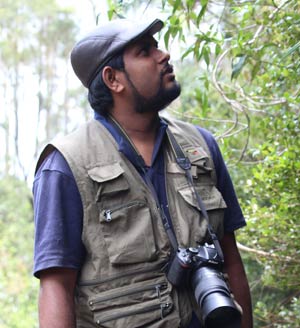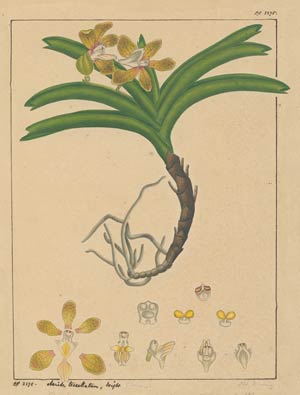Lost and found after 160 years
Nearly lost forever, now this brownish-yellow beauty hidden from the human eye for 16 decades, has been rediscovered in the misty, cool climes of Rangala, nestling within the majestic Knuckles Mountain Range.
The orchid, Vanda thwaitesii, an endemic species to Sri Lanka was rediscovered nearly 160 years after its presumed extinction, marking the first sighting since its initial record in 1861, states a paper in the prestigious ‘Kew Bulletin’ of July 10, this year.

Growing in the wild: The orchid Vanda thwaitesii
The rediscovery had been a part of a project of the ‘National Botanical Survey’ conducted by the Department of National Botanic Gardens, Sri Lanka……..Based on the IUCN (International Union for Conservation of Nature) Red List categories and criteria, V. thwaitesii is assessed as ‘Critically Endangered’, states this peer-reviewed scientific journal published by Springer Science+Business Media on behalf of the Royal Botanic Gardens, Kew, United Kingdom.

Bhathiya Gopallawa
The piece titled ‘Rediscovery of the endemic Vanda thwaitesii (Orchidaceae) after 160 years in the central highlands of Sri Lanka and its lectotypification’ has been written by Bhathiya Gopallawa of the Postgraduate Institute of Science, University of Peradeniya; Indrakheela Madola of the Department of Horticulture & Landscape Gardening, Faculty of Agriculture & Plantation Management, Wayamba University of Sri Lanka; Deepthi Yakandawala of the Department of Botany, University of Peradeniya; Himesh Jayasinghe of the National Institute of Fundamental Studies, Kandy; and Subhani Ranasinghe of the National Herbarium, Department of National Botanic Gardens, Peradeniya.
It had been in October 2020 that a photograph of the orchid had led to the rediscovery……..on finding an “unfamiliar” orchid near his home, nature enthusiast Pradeep Kodituwakku had nurtured it in his garden in Rangala. When it bloomed, he had captured it on camera and sent the image to plant taxonomist, ecologist and conservationist Bhathiya.
Instantly spotting the “uncanny resemblance” of the orchid in the photograph to the unique floral characteristics of V. thwaitesii, Bhathiya had felt a thrill of expectation.
For, it had been British naturalist George Kendrick Thwaites (1812-82) when in Ceylon, who compiled a comprehensive list of flora including this orchid. Even though no specimens were available and he had not observed this species himself, his inclusion of this orchid stemmed from two detailed historical drawings (CP 3378) by Ceylonese botanical artist and illustrator for the Royal Botanic Gardens, Haramanis de Alwis.

Drawing by botanical artist and illustrator for the Royal Botanic Gardens, Haramanis de Alwis now part of the collection of the National Herbarium
Thwaites had named this orchid Aerides tesellatum. But this name had already been given to another orchid before and was taxonomically incorrect. Due to this reason, another British botanist J.D. Hooker in 1898 renamed it V. thwaitesii in honour of Thwaites.
Until 2020, no living specimen had been encountered or documented even though in 1998 India had reported the occurrence of this species, which however was later identified as a different species, Vanda sathishii.
“It was listed as ‘Possibly Extinct’ in the 2020 National Red List of Sri Lanka,” says Bhathiya, explaining that this striking orchid was recorded and illustrated by colonial botanists, but never seen again. Known to science only through those drawings, V. thwaitesii had slipped into obscurity.
Then came the photograph from Rangala and before Bhathiya was the elusive orchid blooming in all its glory. Into action he and Indrakheela, Prof. Yakandawala, Dr. Jayasinghe and Dr. Ranasinghe had got, with institutional backing from the Department of National Botanic Gardens under its ‘National Botanical Survey’ programme.
For field verification, the first visit to Rangala was by Bhathiya and Dr. Jayasinghe. As Pradeep felt that the orchid would be better protected at the Department of National Botanic Gardens, he had requested them to take it there and that is what they did nurturing it in the nursery.
Expectations were high, as the team awaited the flowering of the orchid – with three flowers blooming after one year in 2021.
Very carefully, they had dissected one flower, manually pollinating the other two to obtain seed pods. With photos and evidence in hand, they compared them with the drawings in the National Herbarium.
When the seed pods matured in about six months, seed culturing was performed at the Flori-culture and Research Unit of the Department of National Botanic Gardens. Initially successful, the plants had withered with the reasons being unknown.
It had been on their frequent visits to Rangala that they came across a natural wild population growing on native trees such as Mangifera zeylanica (Atamba) and Mesua ferrea (Na) along the Hulu Ganga.
“We were then able to collect detailed morphological measurements, photographs and seed material. A comprehensive analysis – based on comparisons with historical illustrations and taxonomic literature – left not a shred of doubt. It was indeed the long-lost V. thwaitesii,” says Bhathiya.
For the team, the rediscovery also brings to the fore several issues. Bhathiya says that the known population of V. thwaitesii is restricted to one locality less than 50 metres in extent, with fewer than 10 mature plants. This habitat is beyond the boundaries of any Protected Area (PA) and faces the dangers of degradation and deforestation.

Commending the vital role of communities in conservation, he underscores that around this orchid is the enduring value of botanical curiosity, traditional records, community collaboration and scientific perseverance. If Pradeep did not share his discovery after careful observation, V. thwaitesii may have remained hidden from science.
“This is a powerful reminder that Sri Lanka’s forests harbour secrets. Therefore, we must protect what remains by strengthening conservation measures in biodiversity-rich but unprotected zones such as the Knuckles foothills,” he says.
While the Department of National Botanic Gardens is experimenting with propagating this orchid from seeds to reinforce the wild population and safeguard genetic diversity, Bhathiya urges community-based conservation initiatives, habitat restoration and inclusion of the location from which this orchid blooms in PA networks, as the way forward.
Searching for an ideal partner? Find your soul mate on Hitad.lk, Sri Lanka's favourite marriage proposals page. With Hitad.lk matrimonial advertisements you have access to thousands of ads from potential suitors who are looking for someone just like you.


